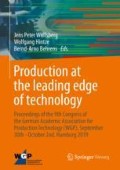Abstract
During the forming of components, inhomogeneous stress conditions lead to residual stresses, which influence the operating behaviour of the manufactured part. Compressive residual stresses generally have a positive effect, while tensile residual stresses reduce the fatigue strength and facilitate crack initiation. Full forward extrusion has been established as an industrial manufacturing technique, where cylindrical billets are formed in the die and ejected in opposite direction. In order to influence the residual stresses state, it is essential to know about its formation. A basic understanding is created by separate investigation of the forming and the ejection step. In the context of this paper, singlephase ferritic stainless steel X6Cr17 and ferritic-austenitic duplex steel X2CrNi- MoN22-5-3 are used. The quantification of the residual stresses states is carried out by X-ray diffractometry, for which a measurement method for duplex steel is validated. The influence of forming and ejection is determined separately by manufacturing components with and without an ejection operation.
Abstract
Bei der umformtechnischen Bauteilherstellung erzeugen inhomogene Spannungszustände Eigenspannungen im Bauteil, welche dessen Betriebsverhalten beeinflussen. Druckeigenspannungen haben positive Auswirkungen, während Zugspannungen die Dauerfestigkeit verringern und Rissinitiierung begünstigen. Beim Voll-Vorwärts-Fließpressen entstehen sie durch inhomogene Spannungszustände während der plastischen Verformung des Werkstoffs. Sowohl bei Umformung als auch beim Auswerfen des Bauteils werden daher Spannungen eingebracht. Im Rahmen dieses Beitrags wird durch Untersuchung der einzelnen Prozessschritte ein grundlegendes Verständnis zur Eigenspannungsentstehung geschaffen. Dazu werden der ferritische Edelstahl X6Cr17 und der Duplex-Stahl X2CrNiMoN22-5-3 untersucht. Die Eigenspannungszustände werden röntgenographisch ermittelt, weshalb eine Messmethodik für Duplex-Stahl validiert wird.
Der Einfluss der einzelnen Prozessschritte wird durch Herstellung von Bauteilen mit und ohne Auswerfen bestimmt.
Access this chapter
Tax calculation will be finalised at checkout
Purchases are for personal use only
Preview
Unable to display preview. Download preview PDF.
Author information
Authors and Affiliations
Corresponding author
Editor information
Editors and Affiliations
Rights and permissions
Copyright information
© 2019 Springer-Verlag GmbH Germany, part of Springer Nature
About this paper
Cite this paper
Jobst, A., Kiener, C., Merklein, M. (2019). Investigations on Residual Stress Generation in Extruded Steel Components. In: Wulfsberg, J.P., Hintze, W., Behrens, BA. (eds) Production at the leading edge of technology. Springer Vieweg, Berlin, Heidelberg. https://doi.org/10.1007/978-3-662-60417-5_8
Download citation
DOI: https://doi.org/10.1007/978-3-662-60417-5_8
Published:
Publisher Name: Springer Vieweg, Berlin, Heidelberg
Print ISBN: 978-3-662-60416-8
Online ISBN: 978-3-662-60417-5
eBook Packages: Chemistry and Materials ScienceChemistry and Material Science (R0)

